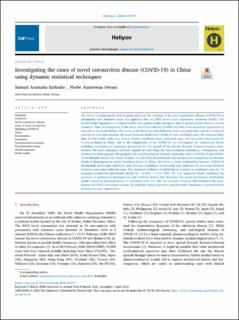| dc.contributor.author | Sarkodie, Samuel Asumadu | |
| dc.contributor.author | Owusu, Phebe Asantewaa | |
| dc.date.accessioned | 2020-07-09T07:22:02Z | |
| dc.date.available | 2020-07-09T07:22:02Z | |
| dc.date.created | 2020-04-12T14:33:26Z | |
| dc.date.issued | 2020 | |
| dc.identifier.citation | Sarkodie, S. A. & Owusu, P. A. (2020). Investigating the cases of novel coronavirus disease (COVID-19) in China using dynamic statistical techniques. Heliyon, 6(4): e03747. doi: | en_US |
| dc.identifier.issn | 2405-8440 | |
| dc.identifier.uri | https://hdl.handle.net/11250/2661514 | |
| dc.description.abstract | The initial investigation by local hospital attributed the outbreak of the novel coronavirus disease (COVID-19) to pneumonia with unknown cause that appeared like the 2003 severe acute respiratory syndrome (SARS). The World Health Organization declared COVID-19 as public health emergency after it spread outside China to several countries. Thus, an assessment of the novel coronavirus disease (COVID-19) with novel estimation approaches is essential to the global debate. This study is the first to develop both time series and panel data models to construct conceptual tools that examine the nexus between death from COVID-19 and confirmed cases. We collected daily data on four health indicators namely deaths, confirmed cases, suspected cases, and recovered cases across 31 Provinces/States in China. Due to the complexities of the COVID-19, we investigated the unobserved factors including environmental exposures accounting for the spread of the disease through human-to-human transmission. We used estimation methods capable of controlling for cross-sectional dependence, endogeneity, and unobserved heterogeneity. We predicted the impulse-response between confirmed cases of COVID-19 and COVID-19-attributable deaths. Our study revealed that the effect of confirmed cases on the novel coronavirus attributable deaths is heterogeneous across Provinces/States in China. We found a linear relationship between COVID-19 attributable deaths and confirmed cases whereas a nonlinear relationship was confirmed for the nexus between recovery cases and confirmed cases. The empirical evidence revealed that an increase in confirmed cases by 1% increases coronavirus attributable deaths by ~0.10%–~1.71% (95% CI). Our empirical results confirmed the presence of unobserved heterogeneity and common factors that facilitates the novel coronavirus attributable deaths caused by increased levels of confirmed cases. Yet, the role of such a medium that facilitates the transmission of COVID-19 remains unclear. We highlight safety precaution and preventive measures to circumvent the human-to-human transmission. | en_US |
| dc.language.iso | eng | en_US |
| dc.publisher | Elsevier | en_US |
| dc.rights | Attribution-NonCommercial-NoDerivatives 4.0 Internasjonal | * |
| dc.rights.uri | http://creativecommons.org/licenses/by-nc-nd/4.0/deed.no | * |
| dc.title | Investigating the cases of novel coronavirus disease (COVID-19) in China using dynamic statistical techniques | en_US |
| dc.type | Peer reviewed | en_US |
| dc.type | Journal article | en_US |
| dc.description.version | publishedVersion | en_US |
| dc.rights.holder | © 2020 The Author(s) | en_US |
| dc.subject.nsi | VDP::Medisinske Fag: 700::Helsefag: 800::Epidemiologi medisinsk og odontologisk statistikk: 803 | en_US |
| dc.subject.nsi | VDP::Samfunnsvitenskap: 200::Økonomi: 210::Økonometri: 214 | en_US |
| dc.source.pagenumber | 5 | en_US |
| dc.source.volume | 6 | en_US |
| dc.source.journal | Heliyon | en_US |
| dc.source.issue | 4 | en_US |
| dc.identifier.doi | 10.1016/j.heliyon.2020.e03747 | |
| dc.identifier.cristin | 1805886 | |
| dc.description.localcode | Unit Licence Agreement | en_US |

